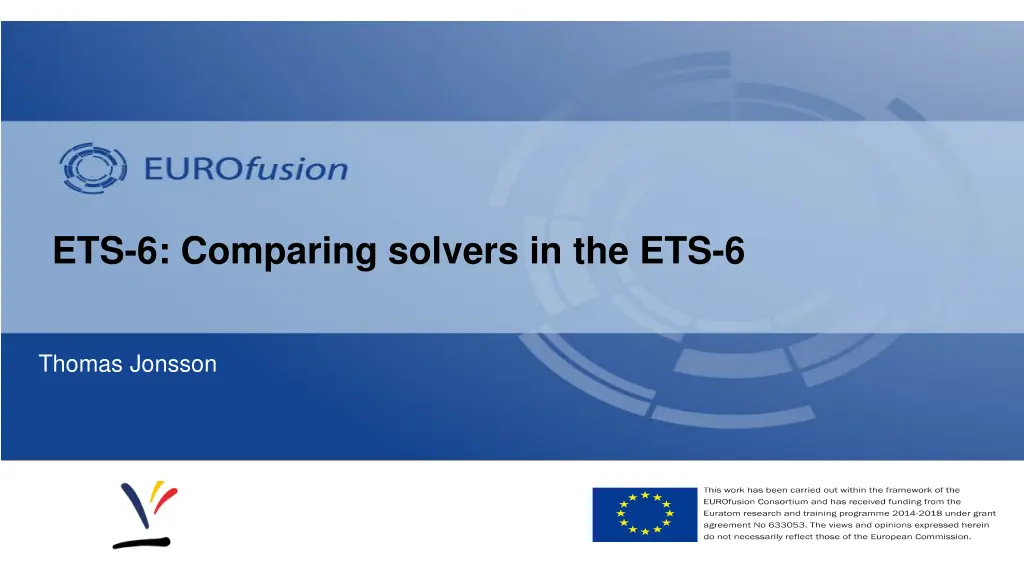
Comparing Solvers in ETS-6 by Thomas Jonsson
A comparison of solvers used in the ETS-6 transport equations, including finite difference and finite element methods. Test results indicate the accuracy and convergence of different solvers in solving diffusion and convection equations, highlighting the performance of FEM over FEM2 and Progonka4. The evaluation also points out discrepancies in results, suggesting a recheck of the implementation for improved accuracy.
Download Presentation

Please find below an Image/Link to download the presentation.
The content on the website is provided AS IS for your information and personal use only. It may not be sold, licensed, or shared on other websites without obtaining consent from the author. If you encounter any issues during the download, it is possible that the publisher has removed the file from their server.
You are allowed to download the files provided on this website for personal or commercial use, subject to the condition that they are used lawfully. All files are the property of their respective owners.
The content on the website is provided AS IS for your information and personal use only. It may not be sold, licensed, or shared on other websites without obtaining consent from the author.
E N D
Presentation Transcript
ETS-6: Comparing solvers in the ETS-6 Thomas Jonsson
Overview Overview Three solvers used to solver the transport equations in the ETS-6 have been compared: solver4 finite difference solver FEM finite element on Kolmogorov backward equation; numerical derivatives of D. FEM2 finite element on diffusion equation; numerical derivatives avoided Compare JET #92436 with modified edge profiles; more smooth. g2tjohns/jet_reference/92436/849 Times: Simulation domain: 49.0 49.5 s dt = 0.01, 0.05, 0.1 n_rho = 50, 100, 200, 400 2025-06-08 Jonsson 2
Four test cases; diffusion and convection Four test cases; diffusion and convection Test2 Test1 Diffusion Convection Diffusion Convection Convection Convection Diffusion Test4 Diffusion Test3 2025-06-08 Jonsson 3
Four test cases; temperature evolution Four test cases; temperature evolution 49.01: After first step 49.41: End of run Test1 Test2 Evolution changes Te by up to ~600 eV Test4 Test3 2025-06-08 Jonsson 4
Test 1, FEM and FEM2 give the same results! Test 1, FEM and FEM2 give the same results! FEM FEM2 In FEM is correct, then errors in FEM2 are large 2025-06-08 5
Test2, Progonka4 and Test2, Progonka4 and SolverFEM SolverFEM converge to the same result converge to the same result Not converging towards solution from Progonka-4, but only ~ 5eV difference! Smaller error in FEM Progonka4 (ref: FEM) FEM (ref: Progonka4) CONCLUSION: FEM is more accurate 2025-06-08 6
Test 2, Errors due to using finite time Test 2, Errors due to using finite time- -step step Progonka4 (ref. Progonka4) FEM (ref. FEM) CONCLUSION: Error due to finite dt are small 2025-06-08 7
Test 2, FEM and FEM2 are very different! Test 2, FEM and FEM2 are very different! In FEM is correct, then errors in FEM2 are large Diverging!! FEM FEM2 CONCLUSION: Suspicious FEM2 results PROPOSE: Check the implementation 2025-06-08 8
Test 3, Smallest error with FEM; different result with FEM2 Test 3, Smallest error with FEM; different result with FEM2 Progonka4 FEM FEM2 CONCLUSION: Similar to Test2 2025-06-08 Jonsson 9
Test Test 4, 4, Smallest error with FEM; different result with FEM2 Smallest error with FEM; different result with FEM2 Progonka4 FEM FEM2 CONCLUSION: Similar to Test2 2025-06-08 Jonsson 10
Conclusions Conclusions Compare Progonka4 and FEM: FEM has smaller error than Progonka4 (in this parameter range) Table show errors at n_rho=100 (independent of dt) Error from finite nrho (eV) Error from finite dt (eV) FEM 15 4 Progonka4 100 ~4 The errors can be compared with a total change in Te due to evolution ~ 600 eV Compare FEM2 with FEM: Identical for D=1 For non-uniform D, FEM2 converges to a different results. 2025-06-08 Jonsson 11
